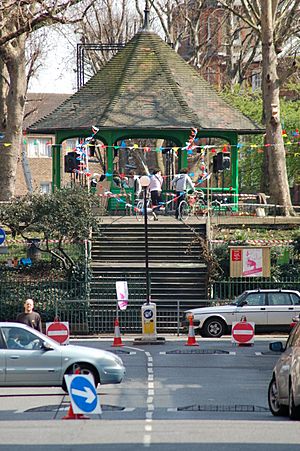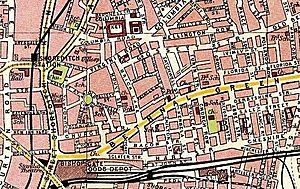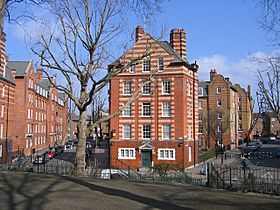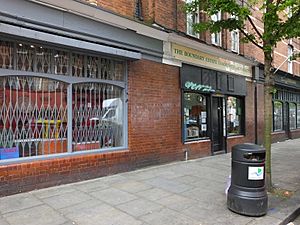Boundary Estate facts for kids
The Boundary Estate is a famous housing area in Shoreditch, East London. It was officially opened in 1900. This estate is special because it was one of the very first social housing projects built by a local government in the UK. It was created to replace a very poor and crowded area known as the Old Nichol slum.
The estate was built starting in 1890. Workers used soil from the foundations to create a small hill in the middle of Arnold Circus. A bandstand was placed on top of this hill, and it's still there today! The estate has many brick apartment buildings that spread out from this central circus. Each building is named after a town or village along the River Thames.
Contents
History of the Boundary Estate
A Difficult Past: The Old Nichol Slum
Before the Boundary Estate, this area was known as the Old Nichol. It was a very crowded and unhealthy place. In the 1800s, many people lived in small, poorly built houses. These homes often had no proper foundations or drainage. There were also no good sewers.
A writer named Henry Mayhew visited the area in 1850. He described how dirty it was. There were often ponds of dirty water and waste. Animals like pigs and cows lived in backyards. The air was bad from different smelly businesses.
Another writer, John Hollingshead, noted in 1861 that the Old Nichol had become even worse. Houses were falling apart. Many people lived in unfit cellars. Running water was only available for a short time each day. This made life very hard for the people living there.
Calling for Change
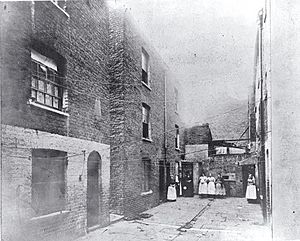
People knew that the Old Nichol slum needed to be changed. A local church leader, Reverend Osborne Jay, started a strong campaign. He wanted to clear out the terrible houses. Charles Booth, a social researcher, had already shown how poor the area was.
Almost 6,000 people were living in the packed streets. The death rate was very high. One out of every four babies died before their first birthday. This was much higher than in other parts of London.
Reverend Jay convinced a writer named Arthur Morrison to visit. Morrison wrote a famous book called A Child of the Jago. This book showed the difficult life of a child in the slum. It helped people understand how bad conditions were.
In 1888, the London County Council (LCC) was created. This new local government group took charge of housing for working-class people. The LCC decided to make the Boundary Street area their main project. They wanted to show how new, good housing could be built.
The Boundary Street Plan
The LCC decided to rebuild a large area, about 15 acres. This included the Old Nichol slum. They planned to move 5,719 people and tear down 730 houses. At first, they thought about building rectangular blocks. But in 1893, they chose a new design. This design had streets spreading out like spokes from a wheel. This allowed more people to live there.
Owen Fleming designed the new Boundary Street plan. He made the main streets wider. He also designed wide, tree-lined streets that led to a beautiful open space called Arnold Circus. The LCC architects designed most of the new apartment buildings. There were 23 blocks in total, with over 1,000 apartments. Most had two or three rooms.
The project was praised for setting "new artistic standards" for housing. It also included a new laundry building, shops, and workshops. Churches and schools in the area were kept. Building started in 1893.
The new apartments were much better than the old slums. However, the original residents often could not afford to live in the new buildings. They were forced to move to other areas further east. This sometimes created new crowded slums there. The new tenants were often clerks, police officers, and nurses.
The project was a big success. The Prince of Wales (who later became King Edward VII) officially opened the estate in 1900. He spoke about how important the work of Reverend Jay and Arthur Morrison had been.
Later, famous brothers Lew Grade and Bernard Delfont moved to the Boundary Estate in 1914. They went to Rochelle Street School, which was nearby. At that time, many children at the school spoke Yiddish.
The Estate Today
Today, the Boundary Estate is still a popular place to live. The buildings are Grade II listed, which means they are important historical buildings and are protected. The bandstand in Arnold Circus is also listed.
The estate's central point, Arnold Circus, has a garden and the bandstand. A group called the Friends of Arnold Circus is working to preserve it. The bandstand was restored in 2010.
One of the roads leading to Arnold Circus is Club Row. This was once famous for its animal market, which closed in 1983.
Protected Buildings and Gardens
Many parts of the Boundary Estate are protected because of their history and design. This includes the gardens at Arnold Circus. Many of the apartment buildings are also Grade II listed. This means they are important and cannot be changed without special permission.
The Rochelle Primary School, built in 1879, is also a listed building. It was one of the early schools built to provide education for all children. Today, Rochelle School is used as a community arts center.
Who Lived Here?
The area around the Boundary Estate has always been home to many different groups of people. In the 1600s, Huguenot refugees came here. They were skilled in silk weaving. This is why some old cottages in the area had wide windows for weaving.
Later, in the mid-1800s, many Irish Catholics moved here to escape the famine in Ireland. At the end of the 1800s, many Jewish people from Eastern Europe came to escape persecution. In the 1930s, more German Jews came to escape the fascists. In the 1960s and 1970s, the Bangladeshi community began to grow in the area.
A church used by the Huguenots later became a synagogue (a Jewish place of worship). In 1976, it became the Great London Mosque, a Muslim place of worship. This shows how the community has changed over time.
Getting Around
The closest London Underground station to the Boundary Estate is Bethnal Green. The nearest London Overground station is Shoreditch High Street railway station. It opened in 2010.
|


